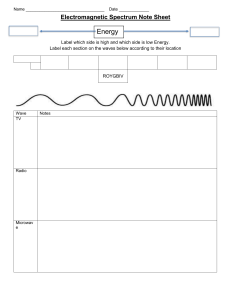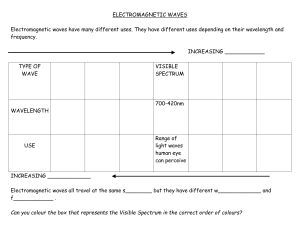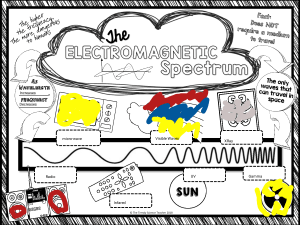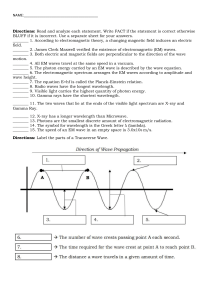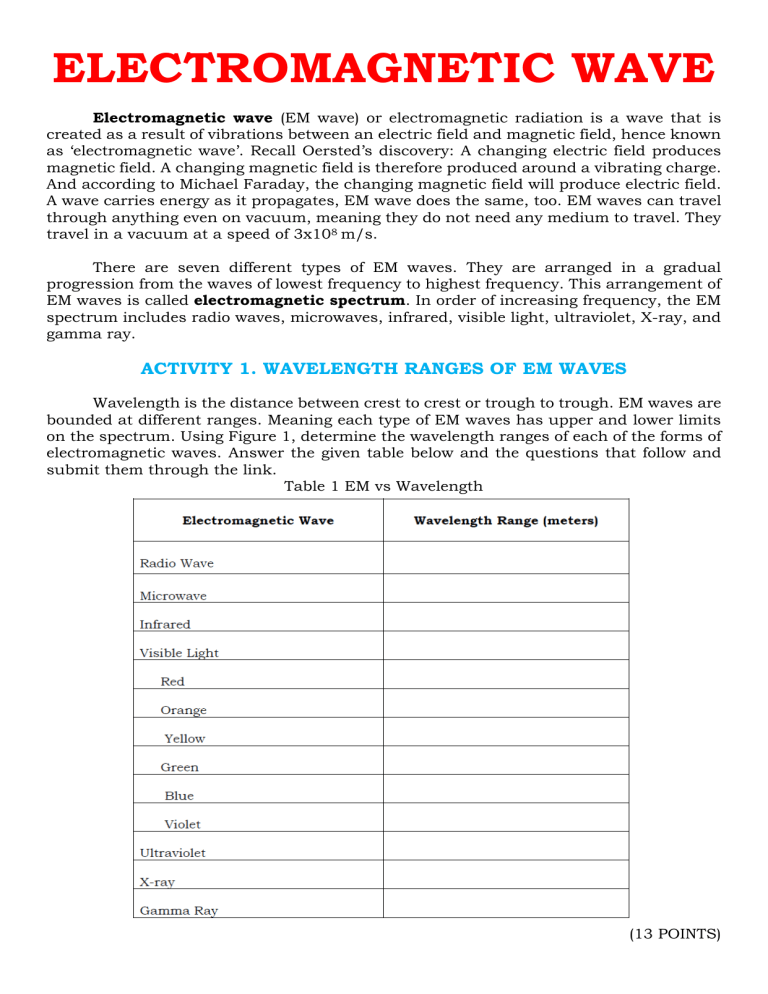
ELECTROMAGNETIC WAVE Electromagnetic wave (EM wave) or electromagnetic radiation is a wave that is created as a result of vibrations between an electric field and magnetic field, hence known as ‘electromagnetic wave’. Recall Oersted’s discovery: A changing electric field produces magnetic field. A changing magnetic field is therefore produced around a vibrating charge. And according to Michael Faraday, the changing magnetic field will produce electric field. A wave carries energy as it propagates, EM wave does the same, too. EM waves can travel through anything even on vacuum, meaning they do not need any medium to travel. They travel in a vacuum at a speed of 3x108 m/s. There are seven different types of EM waves. They are arranged in a gradual progression from the waves of lowest frequency to highest frequency. This arrangement of EM waves is called electromagnetic spectrum. In order of increasing frequency, the EM spectrum includes radio waves, microwaves, infrared, visible light, ultraviolet, X-ray, and gamma ray. ACTIVITY 1. WAVELENGTH RANGES OF EM WAVES Wavelength is the distance between crest to crest or trough to trough. EM waves are bounded at different ranges. Meaning each type of EM waves has upper and lower limits on the spectrum. Using Figure 1, determine the wavelength ranges of each of the forms of electromagnetic waves. Answer the given table below and the questions that follow and submit them through the link. Table 1 EM vs Wavelength (13 POINTS) FIGURE 1 – wavelength ranges of EM waves QUESTIONS: Q1. Which electromagnetic wave has the longest wavelength? Q2. Which electromagnetic wave has the shortest wavelength? Q3. Observe what happens to the wavelength of the electromagnetic waves as they progress (goes rightward from the figure). Does the wavelength of the EM waves increase or decrease as we go from radio wave to gamma ray? Q4. This type of wave was discovered by famous astronomer Sir Frederick William Herschel and has a range of 7x10-7 m to 1x10-3 m. A. infrared B. microwave C. radio wave D. visible light Q5. Which of the following electromagnetic waves has the least wavelength range? A. infrared (7x10-7 m to 1x10-3 m) C. visible light (6.22 x10-7 m to 4.55 x10-7 m) B. x-ray (1 x10-11 m to 1 x10-8 m) D. ultraviolet (1x10-8 m to 4x10-7 m) Q6. Which among the following EM waves has the longest wavelength? A. infrared B. ultraviolet C. visible light D. x-ray Q7. Which electromagnetic wave can travel the farthest distances because it has a wavelength range of greater than 1x10-1 m? A. gamma ray B. microwave C. radio wave D. x-ray Q8. The wavelength of microwaves ranges from 1x10-1 m to 1x10-3 m. Which of the following has size comparable to the wavelength of microwave? A. Bacteria B. Coin C. Human D. Pin ACTIVITY 2 – FREQUENCIES OF EM WAVES Compare the frequencies of different EM waves. Answer the table and the questions follow and submit them through the link. Table 2 – EM vs Frequency (13 POINTS) QUESTIONS: Q9. Which among the EM waves has the highest frequency? Q10. Which among the EM waves has the lowest frequency? Q11. The energy of an EM wave also depends on its frequency, which means waves with higher frequency has higher energy too. Which among the EM waves has the highest energy? Q12. Which among the EM waves has the lowest energy? Q13. What happens to the frequency of the electromagnetic waves as it progresses? Does the frequency of the EM waves increase or decrease as we go from radio wave to gamma ray? Q14. What is the frequency range of infrared radiation? A. 3 x 109 Hz to 3 x 1011 Hz C. 3 x 1014 Hz to 3 x 10 15 Hz 11 14 B. 3 x 10 Hz to 4 x 10 Hz D. 3 x 1016 Hz to 3 x 10 19 Hz Q15. A visible light has a frequency of 6.3 x1014 Hz. What is the color of light? A. blue B. green C. red D. yellow Q16. Which among the following EM waves has the HIGHEST frequency among others? A. infrared B microwave C. ultraviolet D. x-ray Q17. Which of the following EM waves has the LEAST amount of energy? A. gamma ray B. microwave C. radio wave D. x-ray Q18. Which of the following statements is CORRECT? A. Gamma ray has the highest frequency and the highest energy. B. Gamma ray has the highest frequency but has the least energy. C. Radio wave has the highest frequency and the highest energy. D. Radio wave has the lowest frequency but has the highest energy. ACTIVITY 3 – PROPERTIES OF EM WAVES Now that you are already familiar with the wavelength and frequency of EM waves, identify what happens to the wavelength, frequency and energy of the EM waves. You may answer INCREASING or DECREASING. (21 POINTS) EM Waves Wavelength Frequency Energy Radio Microwave Infrared Visible Ultraviolet x-ray Gamma QUESTIONS: Q19. Which has shorter wavelength? X-Rays or Gamma rays Q20. Which has higher frequency? Visible light or Ultraviolet Q21. Which has more energy? Radio waves or Infrared Q22. Which has longer wavelength on visible light? Green Light or Blue Light Q23. Which has lesser frequency? Microwave or Gamma ray Pick out the word that will make the statements correct. Write your answer on a separate sheet of paper. The electromagnetic spectrum is the arrangement of Q24 (electromagnetic waves, ultraviolet radiation), which are waves that are created with changing electric field and Q25 (electric charge, magnetic field). EM waves travel on Q26 (air, vacuum) at a constant speed of Q27 (3 x108 m/s, 8 x103 m/s). The electromagnetic spectrum is arranged in a manner of Q28 (decreasing, increasing) wavelength, Q29 (decreasing, increasing) frequency and Q30 (decreasing, increasing) energy. Q31 (Gamma ray, Radio wave) has the longest wavelength, lowest frequency and lowest energy among all EM waves. The Q32 (radio wave, visible light) is the only EM wave that can be seen by our naked eye, whereas Q33 (red, violet) has the longest wavelength and Q34 (red, violet) has the greatest frequency. On the other hand, Q35 (gamma ray, radio wave) has the shortest wavelength and highest frequency; which carries the highest Q36 (energy, wavelength) among all EM waves. Therefore Q37 (gamma ray, radio wave) has the lowest ionizing radiation, while Q38 (gamma ray, radio wave) has the highest ionizing radiation. Figure 2 – frequencies of different EM waves

